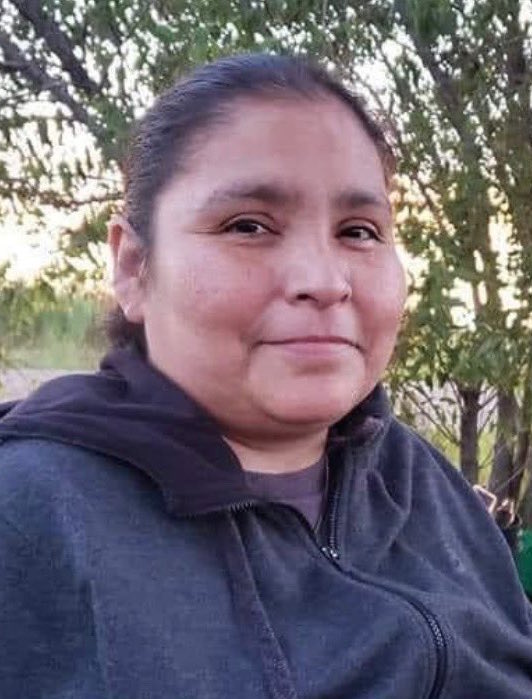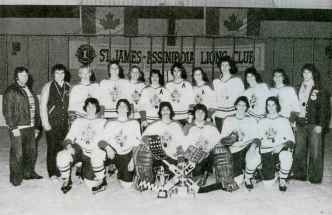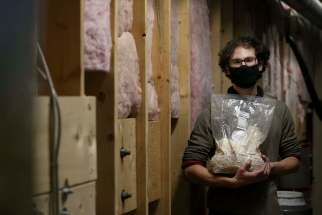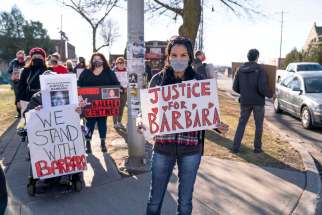Woman reeling after COVID kills Sandy Bay cousins four hours apart Military personnel land in Red Sucker Lake to help community manage outbreak
Read this article for free:
or
Already have an account? Log in here »
To continue reading, please subscribe:
Monthly Digital Subscription
$0 for the first 4 weeks*
- Enjoy unlimited reading on winnipegfreepress.com
- Read the E-Edition, our digital replica newspaper
- Access News Break, our award-winning app
- Play interactive puzzles
*No charge for 4 weeks then price increases to the regular rate of $19.00 plus GST every four weeks. Offer available to new and qualified returning subscribers only. Cancel any time.
Monthly Digital Subscription
$4.75/week*
- Enjoy unlimited reading on winnipegfreepress.com
- Read the E-Edition, our digital replica newspaper
- Access News Break, our award-winning app
- Play interactive puzzles
*Billed as $19 plus GST every four weeks. Cancel any time.
To continue reading, please subscribe:
Add Free Press access to your Brandon Sun subscription for only an additional
$1 for the first 4 weeks*
*Your next subscription payment will increase by $1.00 and you will be charged $16.99 plus GST for four weeks. After four weeks, your payment will increase to $23.99 plus GST every four weeks.
Read unlimited articles for free today:
or
Already have an account? Log in here »
Hey there, time traveller!
This article was published 17/12/2020 (1821 days ago), so information in it may no longer be current.
Alaya McIvor’s two cousins died from COVID-19 within four hours of each other Wednesday.
Both times, she and her family watched via FaceTime as one nurse held the phone and another removed the ventilators from her cousins’ mouths. Both cousins were residents of Sandy Bay First Nation.
Candy Beaulieu was 38. Doot McIvor, 43.
“Our family’s in shock and in disbelief,” she said Thursday, struggling at times to order her thoughts.
But she stressed her cousins deserved to be remembered for who they were as people, not as COVID-19 statistics.
“Candy was social butterfly,” she said. “And (she) had this thing about her. People just grasped onto her and welcomed her into their circles.”
As for Doot, he loved to hunt and travel, she said. He was “someone who likes to put smiles on people’s faces. He was the average Manitoban that was friendly.”
Still reeling from the shock of the tragedy, McIvor, an assistant to MLA Nahanni Fontaine, expressed her family’s gratitude to hospital staff and worry over the trauma faced by medical professionals during the pandemic.
Sandy Bay First Nation, about 90 kilometres north of Portage la Prairie, has not declared an outbreak, but the latest numbers for the region show 54 cases, 36 of which are active, meaning they are contagious, and now there are three deaths.
Across the province, First Nations communities report 1,118 active cases on reserves and another 989 off reserve, totalling 2,107 cases. On Thursday, there were 59 new on-reserve and 39 off-reserve cases reported. And the communities have so far suffered 23 deaths on reserve and 51 off, a total of 74 First Nations deaths in Manitoba.
Test-positivity rates in First Nations communities continue to soar above the rest of Manitoba; the five-day positivity rate on reserve is 22 per cent and 20 per cent off reserve, well above the overall rate in Manitoba of 13 per cent.
First Nations members account for just over 36 per cent of all cases in Manitoba, despite making up about 17 per cent of the population.
“Our support from the government, which is important, it gives us some relief.”
– Red Sucker Lake First Nation Chief Samuel Knott
In Red Sucker Lake First Nation, 35 military personnel landed Thursday to help manage an outbreak of COVID-19. The community of just over 1,000 people had 65 positive cases as of Wednesday evening, said Chief Samuel Knott, who noted that some people still need to be tested or are waiting for results.
“It’s a good feeling knowing that our military is being deployed to our own backlogs,” he said. “Our support from the government, which is important, it gives us some relief.”
A spokesperson for the Canadian Armed Forces said in an email the military will help the community, located about 540 kilometres northeast of Winnipeg near the Ontario border, produce and distribute food, firewood and care packages, while also supporting local health authorities in medical care and setting up alternative isolation accommodations for people who are unable to separate themselves within the same household.
Knott said finding enough space to isolate is a major problem. He said he became ill with the virus last Friday, and since then, his five children have contracted it. They are all recovering.
“Everyone on my team is consistent with saying we need more rapid response team members, and yet they’re being pulled out.”
– Shamattawa First Nation Chief Eric Redhead
Military arrived Dec. 6 in Shamattawa First Nation, where outbreaks of both COVID-19 and tuberculosis have found a firm foothold. About 60 military personnel are currently in the fly-in community 750 kilometres northeast of Winnipeg, providing similar supports to Forces personnel in Red Sucker Lake.
However, while Shamattawa First Nation Chief Eric Redhead said military support has been very helpful, he said he received word Thursday the rapid response team, a crew of medical professionals, will be pulling out of the community of about 1,300 sometime this weekend.
“I feel that’s very, very risky,” he said. “Everyone on my team is consistent with saying we need more rapid response team members, and yet they’re being pulled out.”
Redhead said the community is struggling to get a good snapshot of the virus’s prevalence because testing requirements have changed.
“Testing has actually dropped dramatically…. They’re only testing symptomatic people, which doesn’t really give us a whole lot of information of where the community is at,” he said.
Redhead said “a fair number” of vulnerable people and people who’ve contracted the virus are isolating in Winnipeg, partly due to a lack of space to properly isolate in Shamattawa. Wednesday night, however, the military opened an isolation space in the community.
— With files from Julia-Simone Rutgers and Michael Pereira









